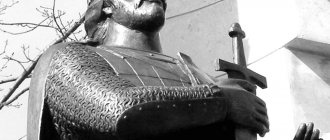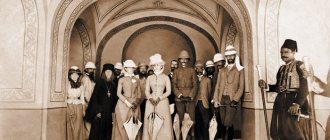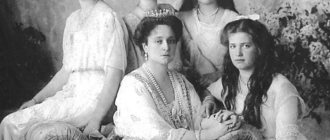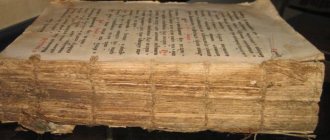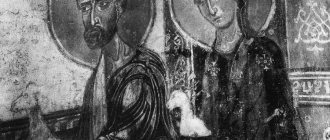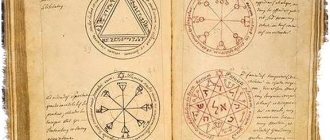| Holy Queen Tamara. Fresco from the 12th-13th centuries, Vardzia Monastery |
Tamara the Great
[1] (c. 1166 - 1213 [2]), blessed queen of Georgia Commemorated on May 1 and the Sunday of the Myrrh-Bearing Women
Born around 1166 [3]. She came from the ancient Georgian Bagration dynasty. Her father was King George III, who successfully resisted the enemies of the country and expanded the influence of Georgia; mother - Burdukhan, an Alan princess distinguished by her beauty and intelligence.
accession
The king had no sons and Tamara acted as heir to the throne. However, Georgia did not have a tradition of the accession of women, and in 1177 the issue of succession to the throne became the reason for the uprising of the nobility under the leadership of John Orbeli, who stood up for the rights of Prince Demna (Dimitri), the nephew of George III. The king brutally suppressed the uprising, but understood that the nobility had been defeated only for the time being and was waiting for the right moment to resume the fight. This prompted George to decide the issue of succession to the throne during his lifetime [4].
In 1178, King George III convened a state council (Darbazi) of archpastors and nobles, at which he declared Tamara co-ruler queen. Until 1184, father and daughter ruled the country jointly [5].
After George III died on Holy Week of 1184, representatives of the highest nobility demanded that Tamara be crowned king again, and the issue of her reign again began to be discussed at Darbazi. Key considerations in favor of the accession of a woman were collected in the treatise of Catholicos Nicholas (Gulaberidze) “Reading on the Life-Giving Pillar,” which emphasized that Georgia was originally intended to be the inheritance of the Mother of God and the preaching of Christianity in the country was carried out by a woman, Equal-to-the-Apostles Nina. This argument turned out to be convincing and the nobles turned to Rusudan, Tamara’s aunt, with the following words:
«
Today you are replacing Tamara’s parents. She, being young, does not look young in mind, but conscious, reasonable and knowledgeable; she obeys and honors you, taking you for now invisible parents. Offer to her and advise her to stop the immeasurable sorrow; let him sit on the throne on which your tall and courageous brother and her father raised her, and show the radiance and power of the crowned family and your house. If she, this necklace and crown of the state, had not been perfect and capable of ruling the kingdom and, speaking pompously, holding it in an Olympian manner, she would not have been entrusted with the throne of David and the seal of Solomon. Let her now begin to reign and, having completed the coronation ceremony, in the presentation of the Life-giving Cross, accompanied by the blessing of Melchizedek, who blessed Abraham, ascend and sit on the throne of her fathers; let him hold the ends of the earth and reign from sea to sea
» [6].
Rusudan supported this proposal and Queen Tamara heeded the request of the nobles, agreeing to a second crowning. During her coronation, the young queen showed exceptional generosity, distributing countless treasures for the needs of the poor and the Church. She promised that she would persecute lawlessness, double-mindedness and other vices, encourage virtue, support legal principles, and take care of the people's well-being and the greatness of the fatherland. The people were delighted with the queen [7].
The author of her “Life” described young Tamara as follows:
«Correctly built body, dark eye color and pink color of white cheeks; shy look... pleasant language, cheerful and alien to any swagger, speech that delights the ear, conversation alien to any depravity
» [8].
Marriages and accession to the throne
| Blgv. Queen Tamara. Fresco (beginning of the 13th century) in the Church of the Nativity of the Virgin Mary of the Bethany Monastery |
From the very beginning of her reign, Tamara showed remarkable intelligence, being concerned, first of all, with electing the most worthy persons to the positions of advisers (viziers) and military leaders.
She made her close associates Anthony Glonistavisdze from Gareji and two sons of the chief governor (amirspasalar) Mkhargrdzeli: Zacharia and Ivane, who later showed themselves to be faithful and skillful people. At the same time, Tamara provided the bishops with donations, freeing the churches from dues and taxes, and tried to gather people of righteous life to her. Some of the senior officials conspired to rise even higher and not to let new associates higher up the career ladder pass. The treasurer (mechurchletukhutses) Kutlu-Arslan openly proposed to create some kind of parliament that would deal with the affairs of government, and the power of the queen would be reduced only to the formal approval of all the laws they adopted. Tamara detained Kutlu-Arslan. The military stood up for him, but the confrontation was resolved through negotiations.
In 1185, by unanimous decision of the patriarch, bishops and courtiers, it was decided to find a husband for young Tamara. For this purpose, the merchant Zerubbabel was sent to Rus', “due to the belonging of the Russian tribes to Christianity and Orthodoxy” [9], who wooed the queen Prince Yuri (George) Andreevich, the son of the Grand Duke Andrei Bogolyubsky. The courtiers approved of the groom, and although Tamara asked “to wait until you see his merits or demerits” [9], the Georgian nobles insisted on their own and arranged the wedding.
Soon Tamara’s fears were justified: her husband showed himself to be a drunkard who committed “many indecent things” [10]. For two and a half years the saint endured her husband’s vices, addressed him through worthy monks, and then she herself began to denounce him face to face. But Yuri became even more furious and began to commit more destructive offenses. Then Tamara, “shedding tears, sent him into exile, providing him with untold wealth and jewelry” [11].
Thanks to her natural beauty, intelligence and charm, the saint became a desired bride for many kings and princes from all over the world. The eldest son of Emperor Manuel Komnenos sought her hand; several sultans were ready to renounce Islam for her sake. But Tamara remained adamant, since, due to her innate craving for purity, she generally wanted to remain celibate. Only yielding to the convictions of the courtiers, who were worried about the lack of an heir, did she finally agree to marry in 1188 the pupil of her aunt Rusudan, the Alan prince David Soslan. This marriage turned out to be successful: in David, Saint Tamara found a wonderful husband and a fearless military leader. Soon Tamara gave birth to an heir, the future Tsar George IV, and then a daughter, Rusudan.
Having learned about the second marriage of the holy queen, her first husband decided to compete for the lost throne. He came to the country of Ezinkan (Erzincan), where numerous traitors joined him and went to war against Tamara. The rebel army was defeated in a night battle near the Kura River, but the saint showed mercy and did not execute any of the traitors, and released her ex-husband. Subsequently, Yuri Andreevich tried twice more to regain the Georgian throne, but each time he was beaten by vassals loyal to Tamara.
Foreign policy
| Blgv. Queen Tamara the Great. Georgian icon (X-XXI centuries) |
Ten years after ascending the throne, Queen Tamara launched an offensive policy against neighboring Muslim states.
Her forces took Khorasan, Tabriz (now Tabriz) and Erzurum. In response, the Baghdad caliph decided to conquer the growing Christian Georgia and in 1195 gathered a powerful united army of the Muslim world against it, including forces from India, Samarkand and Derbent under the command of the atabek of Azerbaijan Abu Bakr. Having learned about the impending invasion, Saint Tamara ordered the dissemination of a decree so that an army would immediately gather, all-night vigils and litias would be held in all churches and monasteries, and the courtiers would send “more money and everything needed for the poor” [12]. In ten days they managed to gather a considerable army. The saint turned to the soldiers: “My brothers, do not be afraid because there are so many of them and you are few, because God is with us” [12]. After which she entrusted them to God, and she took off her shoes and came barefoot to the Church of the Mother of God in Metekhi, where, falling in front of the holy icon, she did not stop praying with tears. Georgian troops won a brilliant victory near Shamkhor (now Shamkir), capturing many enemy soldiers. The great victory brought glory to the queen, but her biography emphasizes that the blessed Tamara did not succumb to pride, but “on the contrary, she became even more humble before God” [13]. Another difficult test for the queen and the country was the battle with the Sultan of Rum Rukn ad-din. Having feignedly concluded a series of peace treaties with Tamara, he gathered a large army throughout his power, and in the early 1200s he spoke out against her, declaring that life would be left “only to those who profess the faith of the Prophet Muhammad, reject your faith and begin to break with their own hands.” cross" [14]. Tamara, placing all her trust in God, called the courtiers and began to confer with them “not like a woman and not with disregard for the dictates of reason” [14]. In a few days it was possible to gather soldiers, who first went to the Church of the Blessed Virgin Mary in Vardzia. The queen entrusted her husband and his entire army to the Mother of God, and she herself devoted herself to fasting and prayer. In the Battle of Basian, the Georgians defeated the enemy, took rich trophies and again repelled the threat hanging over the Christians. The biography preserved a letter from the blessed queen to Sultan Rukn ad-din, written on the eve of the battle:
«Having entrusted myself to Almighty God the Almighty and eternally praying to the Virgin Mary and trusting with faith in the honorable Cross, I read your message, which angers God, Nucardin. Anyone who falsely swears in the name of the Lord will be wiped off the face of the earth by God. I am sending a Christ-loving army to crush your pride and arrogance
» [15].
The blessed queen, continuing the expansion of the state in the fight against Muslim countries, also contributed to the creation of the Roman Empire of Trebizond, allied with Georgia. Having received her relatives, the exiled Roman princes Alexy and David Komnin, she found herself in confrontation with their persecutor, Emperor Alexy III Angelos. The impetus for the aggravation of relations was the withdrawal by Alexy Angel of the generous gifts that Tamara bestowed on the monks who came to her. Having learned about this, the queen sent even greater quantities of gold to the name of the reverend fathers. Then, in 1204, she sent an army to the northeastern borders of the Roman possessions and installed Alexius Komnenos as emperor over these lands, with his capital in Trebizond.
Thus, during the years of her reign, the blessed Queen Tamara humbled internal and external enemies, expanded the boundaries of the kingdom and gave Georgia predominant political importance throughout Asia Minor. The queen was able to take the place of arbiter over a vast region - according to the chronicler, “she sat as a judge between neighboring kings, making sure that no one started wars or tried to throw the yoke of violence on each other” [16]. At the same time, Tamara herself did not relax under the influence of time and did not show disdain for management.
Internal management
| Blgv. Queen Tamara. Fresco early XIII century, St. Nicholas Church of the Kintsvis Monastery |
The reign of Saint Tamara is known as the golden age of Georgian history, not only from the political side, but also from the spiritual and cultural.
The queen's high piety and wisdom manifested themselves in many deeds, but the blessed Tamara became especially famous as a guardian of Orthodoxy, a generous patron of the Church and the arts. Immediately after her election, Saint Tamara announced the convening of a Church Council, to participate in which she called the former Catholicos of Mtskheta Nicholas from Jerusalem and, under his chairmanship, gathered numerous clergy teachers, monks, hermits and experts in the law of God from all over the kingdom. Having seated everyone in one room, the queen sat down at a distance and said:
«Oh, holy fathers, examine everything well and establish what is straight and drive out what is crooked. Do not be partial to princes because of their wealth, and do not despise the poor because of their poverty. You in word, and I in deed, you in teaching, and I in teaching, you in instruction, and I in institution, let us all give each other a helping hand in order to keep God’s laws undefiled
» [17].
Guided by this order, the Council eliminated troubles in church life and removed unworthy hierarchs. Subsequently, the queen did everything to ensure that during her reign the rite of church service was carried out in full, according to the instructions of the Typikon and according to the Rules of the Palestinian monasteries. In the palace itself, prayer services and vigils were continuously served, and the Bloodless Sacrifice was offered. Saint Tamara cared a lot about the improvement of God's churches: in Kartli during this period the churches of Ikorta, Betania, and Kvatakhevi were built; Lurgi Monastery was built in Tbilisi; An outstanding monument was the Vardzia monastery complex carved into the rock in Javakheti; the Vakhan Monastery, carved nearby at the same time, is also noteworthy.
| Breast cross of St. Queen Tamara, XII century. (GMIG) |
Caring for the welfare of the Georgian Church, the queen contributed to the spread of the faith of Christ in her lands.
Her special concern for the Christian education of her half-blooded Alans is known. Blessed Tamara also cared about God’s people and abodes far beyond the borders of her domain. She sent her confidants to distant countries, sending with them chalices, paten, covers for shrines and innumerable gold for monks and beggars. In the circle of her beneficence were Libya, Greece, Macedonia, Bulgaria, Thrace, Isauria, Cyprus; monasteries of Alexandria, Constantinople, Sinai, Holy Mount Athos and the Black Mountain. Under the holy queen, Georgian culture experienced an unprecedented flourishing. Such outstanding poems are being written as “Abdul-Messiah” by St. John Shavteli, “The Knight in the Tiger’s Skin” by Shota Rustaveli and “Tamariani” by Chakhrukhadze. In addition to the magnificent temples, numerous new buildings are being created, such as the Geguta Palace, as well as the masterfully crafted Besletsky, Rkonsky and Dandalo bridges.
The prosperity of Georgia under Tamara was also based on her special concern for the poor. She placed faithful caretakers over the needy and gave a tenth of all state income to the poor, and made sure not even one grain of barley was lost. Executions have stopped in the country; in all of Georgia it was impossible to meet a single person who would have been subjected to violence with the knowledge of the queen. During the 31 years of her reign, by her order, no one was punished even with a whip [18].
Georgian legends glorify the piety, meekness, peacefulness, wisdom and beauty of the holy queen. People loved her without looking back and animals obeyed her: the biography writer speaks of a lion that grew up at her court, who laid his muzzle on the queen’s lap, fawned over her, and when he was taken away, he wept profusely [19]. Her name was famous as “the name of the angel of the four corners of the world, from east to west, from north to south” [20].
Saint Tamara was imbued with fear of the Almighty and served God faithfully. She made every effort to ensure that “her human nature remained simple, according to the nature of her internal makeup, without connection with passions” [21]. The queen amazed those close to her by the fact that she “spent the whole night standing on her feet, staying awake, praying, bowing and tearful supplications to the Lord, as well as doing needlework to help the poor” [22]. The queen rejoiced at the opportunity to help the poor and infirm, and she had a special love for priests and monks.
Last years and death
In 1206, the husband and co-ruler of Saint Tamara, David Soslan, died. The queen made her son George Lasha her co-ruler, and she herself began to prepare for her death. She spent the last years of her life in the cave monastery of Vardzia, where the blessed queen had a cell connected through a window with the temple, from which she could offer prayers to God during services. At first she took care of state affairs, then she dealt with church and monastic affairs, after which she developed an unknown illness. Human skill and widespread prayers for her recovery did not change the course of events. On the threshold of transition to another world, Saint Tamara summoned eminent people of the kingdom and addressed them with the words:
«My brothers and children! So I am called by the Terrible Judge. I kept love for you in my heart. I pray to all of you to do good deeds and remember me. I leave you my children, George and Rusudan, as heirs of my house, accept them in my place
» [23].
Then Tamara turned to God:
«Christ, my One God, I entrust to You this kingdom, which You have entrusted to me, and this people, redeemed by Your honest Blood, and these children of mine, whom You have given to me, and then my soul
» [23].
With these words, the blessed queen of the Georgian people died peacefully and quietly. Her death is most often dated to January 18 [24] 1213 [25].
Relics and veneration
| St. blgv. Tamara Gruzinskaya |
According to the life writer, with the repose of the holy Queen Tamara, “the sun of Georgia went out,” and the joy of the Georgians gave way to grief: “their lips became like the earth, deprived of salt” [26].
According to “The Life of the Queen of Queens Tamar,” the ashes of Saint Tamara were placed in the cathedral in Mtskheta for several days, and then buried in Gelati in the Bagration family tomb. However, in fact, the true resting place of her relics remained hidden. Knowing that the enemies of Christ would want to take revenge on her after her death, she bequeathed to bury herself secretly so that the grave would remain hidden from the world. At night, ten detachments left the gates of the castle where the queen died. Each one carried a coffin, and all ten coffins were secretly buried in different places. No one knew which of them contained the queen's body. According to one legend, she was buried in the Gelati monastery. Another tradition claims that she was buried in the Jerusalem Cross Monastery, as she promised to make a pilgrimage to Jerusalem, but during her lifetime she could not do this, and the new king George Lasha fulfilled her mother’s cherished desire. Queen Tamara's contemporaries left two major biographies of the saint that have remained throughout the centuries. “The Life of the Queen of Queens Tamar” [27] was written, according to the most authoritative Georgian researchers, by the queen’s close associate Vasily Ezosmodzgvari and is dedicated primarily to the moral character of the saint. Another work - “History and Praise of the Crowned Bearers” [28] - was written in a more secular vein by an eyewitness to most of the events he describes and is replete with detailed geographical information, descriptions of battles and state councils. Information about the life of the saint is also contained in decrees and documents such as deeds of gift.
Both her personal piety and the unprecedented prosperity of Georgia under her hand contributed to the formation of special veneration around her name. Along with Equal-to-the-Apostles Nina, the blessed queen became the most revered and beloved saint among Georgians. The veneration of the holy queen, conciliarly approved by the Church, was supplemented by various folk legends and beliefs. Over time, veneration of the saint began to spread to other Orthodox nations. In Rus', from the second half of the 16th century, the “Tale of Queen Dinara”, based on the events associated with the glorious Battle of Shamkhor, received wide circulation. In connection with the 800th anniversary of her death, the Georgian Orthodox Church declared 2013 the year of Queen Tamara [29].
How Tamara fought with her ex-husband
The queen's first marriage was unsuccessful. Her wife was chosen by the religious elite. Of course, he had to profess Orthodoxy. The choice fell on Georgy (Yuri), the son of Andrei Bogolyubsky. Unlike his father, George did not possess the talent of a commander and politician. He preferred taverns, booze and women (according to some legends, men) to battles. Tamara quickly became disillusioned with her husband and two and a half years later demanded a divorce. You have to understand that divorce was unthinkable back then. However, the church agreed. Perhaps the reason for this was the reforms started by Tamara at the beginning of her reign. She placed people devoted to her at the head of the church, who were not seen in extorting money and abusing their power. In addition, churches were exempt from duties, and generous funds were allocated from the treasury for their existence. The queen also secured the support of the elite - she significantly expanded the powers of the councils of the nobility. The lower strata of the population were also satisfied with their lot; they were freed from heavy taxes.
The Georgian church canonized Tamara as a saint. (wikipedia.org)
So, no one interfered with Tamara’s divorce. And here the most interesting thing begins: the queen sent George into exile, providing him with a large sum of money. The act is noble. The rejected husband went to Constantinople, and then returned to Georgia with his army to take revenge. Tamara had to fight with her ex-husband. True, the army devoted to her quickly expelled the unlucky husband from the borders of the kingdom.
Legends attribute numerous lovers to the beautiful Tamara. But this is nothing more than artistic fiction, a kind of attribute of a romantic image. One thing is certain: the young widow was looking for a husband on her own. Her chosen one was the Ossetian prince David-Soslan. There were no disagreements with the second spouse; in addition, he was a talented military leader.
Arrival of the Russian groom
In 1185, the merchant Zankan Zorababeli was “sent” to the Polovtsians in order to deliver Yuri before the dark eyes of the Queen of Georgia. As soon as Zorababeli and Yuri crossed the threshold of the royal chambers, the nobles immediately began to prepare for the wedding.
Despite the fact that, judging by the chronicles, Yuri Andreevich had an ideal physique and a handsome face, Tamara asked not to rush into the wedding. According to the author of the book “From Queen Tamara to D'Artagnan” Natalia Basovskaya, the ruler believed that she needed some time to think, and most importantly, to observe the groom, to see all his advantages and disadvantages. But the subjects did not want to listen to anything. They even managed to rename Yuri to George in the Georgian manner.
The expedition that never happened
The coffin with the body of Queen Tamara was searched for eight centuries. All places that could become the last refuge of the legendary ruler were carefully examined: the royal cemetery of Gelati in Mtskheta, the monastery on the slopes of Mount Kazbek, caves in the Kasar Gorge and many others. All searches ended in failure. Gradually, archaeologists and amateur searchers gave up trying to find the resting place of the queen or at least one of the three women killed after her death. But scientists early abandoned the opportunity to reveal one of the historical secrets. There is a place in Georgia where one of the coffins can be kept. I found out about it more than 30 years ago - completely by accident. Unfortunately, I was never able to organize my expedition. The USSR broke up into separate independent countries. The supposed burial place of Queen Tamara remains in Georgia, with which Russia today has strained relations. But sooner or later, countries that have lived together for hundreds of years must make peace, and then such an expedition will become a reality.
Mysterious cave
In the winter of 1967, athletes from the Moscow Geological Exploration Institute, under the guidance of their coach, master of sports in mountaineering Eduard Grekov, climbed the peaks in the Georgian corner area. Among them was the author of this article. Our first overnight stay was in a kosh, located in the upper reaches of the Kistinka River. As often happens, the excitement from the dark beauty of the mountains surrounding the gorge and the spectacle of the fast river carrying its waters to the Terek kept us awake, and we spent half the night listening to our trainer’s stories about his adventures in the mountains. Among others, we heard a story that was directly related to Queen Tamara. Around 1963-1964, a tragedy occurred on the Georgian Military Road, near the high-mountain village of Kazbegi. At a sharp turn, the driver was unable to hold the car, and it, along with four passengers, collapsed into the Terek gorge. The mountain rescue team that arrived at the scene had to lift the bodies of the dead travelers onto the road. While descending down the climbing rope, one of the rescuers saw under the ledge of the rock a dark opening of the entrance to the cave, blocked by a forged rusty grate. Attempts to “pump up” to the exit were unsuccessful. The rescuers did not have a cat with which to cling to the grate, so the exploration of the cave was postponed until better times. But they never came. The following year, all participants in the rescue work died while climbing one of the peaks.
Tamara's childhood
The chronicles say that Tamara was born in 1166 into a family belonging to the Bagration dynasty. George III, her father, was the grandson of David the Builder, and her mother Burdukhan was the daughter of the king of Alanya Khudan. To commemorate the birth of the heiress, George III ordered the construction of the Church of the Nativity of the Virgin Mary - it still stands in Tbilisi today, but is now dedicated to Our Lady of Didubi. Tamara was left without a mother early, and her mentor Rusudan was in charge of her upbringing. It was she who managed to raise the girl not just as a woman, but as a genuine queen. Tamara owes her an excellent education for that time. And she was able to demonstrate her extraordinary abilities at a young age. The first test for the future ruler was the rebellion that occurred in 1177. Then the Orbeliani clan, suppressed by George III, rebelled against him. Since George III had no sons-heirs, and the situation in the country was unstable, he decided to crown his daughter during his lifetime. As a result, in 1178 Tamara was crowned king in Uplistsikhe, after which she formed a ruling tandem with her father.
Years of reign
In 1184, George III died, leaving his daughter and the state with strained relations with the church. After the death of her father, Tamara was crowned a second time, after which she began solving problems with the church and various administrative matters. She ordered the abolition of duties for churches, and removed the bishops who had committed misconduct from their cathedras. Talented compatriots were appointed to the positions of military leaders and ministers. According to the chronicler, during the reign of Tamara, peasants became a privileged class, nobles became nobles, and the nobles themselves became real rulers. The young queen showed diplomacy on the issue of changing the political system in the country. A supporter of changes, Kutlu-Arslan gathered like-minded people who demanded the creation of an independent body at court. The persons elected to this hypothetical organization wanted to resolve all state issues without the participation of the queen herself, and leave the latter only executive functions. But after the arrest of Kutlu-Arslan, his minions were agitated and began negotiations with the queen, who managed to win them over to her side. So the attempt to rebuild the work of the state system, made by Kutlu-Arslan, ended in nothing. But Tamara understood that in order to successfully continue her concerns about the state, it was necessary to provide her subjects with education, so she placed special emphasis on educating the population in schools. They taught astrology, theology, arithmetic, foreign languages and other disciplines that were not even taught in other countries.
History of government
George died in 1184, leaving his daughter not only the state, but also strained relations with the local clergy. That same year, Queen Tamara was re-crowned in Gelati, after which she began to eliminate troubles in the church environment and restore administrative order. By her command, churches were freed from duties, and unworthy bishops were removed from the see.
During approximately 30 years of her reign, Queen Tamara did as much as no previous ruler of Georgia could do:
completed the work begun by her ancestors - created a perfect Georgian army; conquered Erzurum and Temriz;
defeated the Sultan of Ardabil;
emerged victorious in the Battle of Shamkor, defeating the Aleppo Sultan Nucardin; contributed to the development of romantic literature in prose and the improvement of the Georgian language;
spread citizenship and Christianity among the Caucasian highlanders.
Thanks to the spoils of war and tribute collected from conquered territories, Georgia became one of the richest countries in the medieval world. With the funds received, Queen Tamara built many temples, castles, and defensive structures, including the Vardzia Palace (now a cave monastery) in Javakheti.
The queen understood that to continue her endeavors, Georgian subjects needed a good education, so she made every effort to expand the school curriculum. Children were taught theology, arithmetic, astrology, foreign languages and many other subjects that were not taught in other countries.
During Tamara's reign, the best musicians, writers, philosophers and poets gathered at the court. It was during her reign that the poem “The Knight in the Skin of a Tiger” appeared, in which Shota Rustaveli sang such human qualities as military valor, courage, generosity and friendliness.
As for Tamara’s personal life, she got married for the first time in 1185. Her political rather than spiritual choice was Prince Novgorod - Yuri Andreevich Bogolyubsky, who turned out to be a drunkard and a man with many vices. The queen tolerated his unworthy behavior for two years, and in 1187 she sent him into exile and dissolved his marriage. The second husband of the ruler was David Soslani, a prince from Ossetia, who for many years was a reliable ally of Tamara and gave her a son, George IV Lasha.
St. Paphnutius Borovsky
Discussion: 3 comments
- Tamara:
10/15/2010 at 00:00thank you for the life of Queen Tamara, whom I greatly respect and I hope through her prayers peace will come to Georgia someday
- nun Irina:
05.11.2012 at 00:00
Thank you for your love and veneration for our saints, may goodness and love of your guardian angel reign in our hearts
- Novel:
01/27/2018 at 20:28
St. Tamara pray to God for us sinners. My one is one of the most revered saints, as my mother’s name is Tamara.
Personal life of the queen
Queen Tamara first got married in 1185, and Prince Yuri Bogolyubsky of Novgorod became her chosen one (more political than cordial). However, he turned out to be a drunkard and had many other vices. For 2.5 years the queen tolerated his vices, appealing to him through worthy monks, and later began to denounce him to his face. But the vicious Yuri only became furious at this and began to behave even more defiantly. Tamara had no choice but to send him, shedding tears, into exile, providing him with jewelry and other wealth. As a result, the worthless husband settled in Constantinople in 1187. There, the retired husband, who became Tamara’s enemy, gathered a large Greek army, with which he moved to Georgia to regain the lost throne. His supporters captured Kutaisi, where he was crowned in the Geguti Palace. Supporters of the impostor staged raids all the way to Gori, but their rebellion was suppressed. Tamara in 1191 again expelled Yuri, punished his henchmen, for example, deprived the Jakeli clan of possessions. Tamara married for the second time to the prince from Ossetia David Soslani, who for many years was her reliable like-minded person. It was no coincidence that the courtiers insisted on his candidacy, since he was raised by Queen Rusudan’s own aunt. Historians have even suggested that this dynastic marriage was a wise strategic move by the Georgian elite. At that time, Georgia needed allies, and the neighboring Ossetians had a fairly powerful army. This could not but be taken into account by the ruling circles of Georgia, which happily recognized Soslan-David as co-ruler of the country. This union made the Georgian state prosperous and more powerful and brought both peoples closer together. The couple ruled the country in complete harmony. When a rumor spread among the people that the queen was pregnant, everyone began to pray for a boy to be born. And so it happened, and the first-born son born to the royal couple looked like his grandfather, so he was also named George. And a year later, a daughter, Rusudan, was born.
